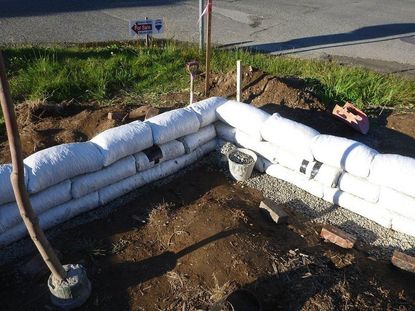Earthbag Gardens: Tips For Building Earthbag Garden Beds

For higher yields and ease of use, nothing beats a raised bed garden for growing vegetables. The custom soil is full of nutrients, and since it never gets walked on, stays loose and easy for roots to grow into. Raised bed gardens have had walls made of wood, concrete blocks, large stones, and even bales of hay or straw. One of the most solid and dependable materials for building a garden bed is an earthbag. Discover how to build an earthbag garden bed using this simple earthbag construction guide.
What are Earthbags?
Earthbags, otherwise known as sandbags, are cotton or polypropolene bags filled with native soil or sand. The bags are stacked in rows, with each row staggered offset from the one below it. Earthbag gardens create a stable and heavy wall that will withstand flood, snow, and high winds, protecting the garden and plants within.
Tips for Building Earthbag Garden Beds
Earthbag construction is easy; just buy empty bags from bag companies. Often these companies have printing mistakes and will sell these bags at a very reasonable price. If you can't find classic sand bags, make your own by purchasing cotton sheets or using old sheets from the back of the linen closet. Make a pillowcase shape without the hem using two simple seams for each earthbag. Fill the bags with the soil from your yard. If your soil is mostly clay, mix in sand and compost to make a fluffier mix. Solid clay will expand and you'll run the risk of the bag splitting. Fill the bags until they are about three-quarters full, then lay them down with the opening folded underneath. Make a line of bags all around the perimeter of the garden bed. Curve the line in a half-circle or serpentine shape for added strength to the wall. Lay a double line of barbed wire on top of the first row of earthbags. This will grip the bottom and top bags when they are placed together, holding them in place and preventing the top bag from slipping. Tamp each bag with a hand tamp after you settle it in place. This will compact the soil, making the wall more solid. Lay the second row of bags on top of the first, but offset them so that the seams are not on top of each other. Fill the first bag in the row only partially to create a shorter bag to start. Plaster over the entire wall when you've finished building and allow it to dry before adding soil to finish the earthbag garden bed. This will protect it from moisture and sunlight, helping to keep the wall stable longer.
Gardening tips, videos, info and more delivered right to your inbox!
Sign up for the Gardening Know How newsletter today and receive a free download of our most popular eBook "How to Grow Delicious Tomatoes."